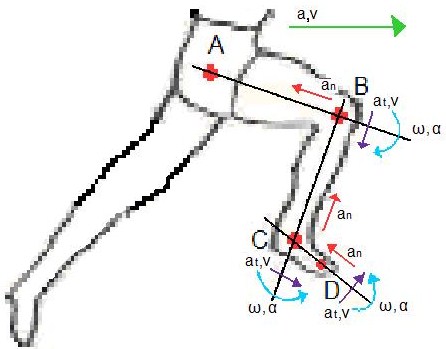Relative Motion Analysis
 The
blue arrows in figure
represent the angular velocity and angular acceleration of the link it
is
associated with.
The
blue arrows in figure
represent the angular velocity and angular acceleration of the link it
is
associated with.The purple arrows represent
the tangential acceleration and velocity of the point at the end of
each link.
The red arrows represent the
normal acceleration of the link it is associated with.
The green arrow represents
the acceleration and velocity of the body as a whole. In fact the green
arrow
can represent point A as it is the only point that isn’t rotating or
moving in
a curvilinear motion. The green arrow is straight indicating that the
body is
moving in a rectilinear motion.
In order to bring in
relative motion analysis let’s say that we have recorded the motion of
the
runner’s body on camera, so we know the velocity and acceleration
directions
and magnitudes of the body or of point A. Let’s also say that we know
the
angles of each link with respect to the x axis and the length of each
link. Since we have the camera we can
measure the
change in angles and we know the change in time.
Given all this information
we can calculate the velocity and acceleration of all the other points
on the
body.
These equations will prove
to be helpful:
ω = dθ/dt,
v = ω*r,
where
r is the length of the link
at = α*r,
an = ω²*r,
a = (at² + an²)^1/2
For point B:
Velocity
vB = vA + vB/A, where vB/A is the relative velocity of “B with
respect to A”
The relative motion is
circular and the magnitude vB/A = ω*rB/A
vB = vA + ω*rB/A,
We know the change in angle
and time so we know the angular velocity and we just use the equation
to get
the velocity of point B. Note: The equation would have to be used for
the x and
y direction and be used in the following equation:
Acceleration
aB = aA + (aB/A)t + (aB/A)n,
and (aB/A)n is the
relative normal
acceleration component of “B with respect to A.”
The angular acceleration can
be found out by looking at two frames captured by the camera before the
frame
we are looking at to obtain the initial and final angular velocity to
get the
angular acceleration. Note: The equation would have to be used for the
x and y
direction and be used in the following equation:
| Home |
Kinematics Terms |
Sideview of Runner |
Frontview of Runner |
Relative Motion |
Bibliography |